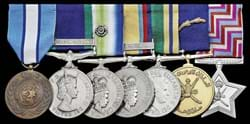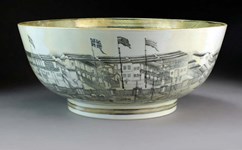
The medals were earned by SAS Corporal Ian White, who was part of Operation Nimrod – the storming of the Iranian Embassy in 1980. The black-clad, gas mask-wearing figures captured by television cameras brought the regiment firmly into the public consciousness and established the unit’s super-tough reputation. White was in the thick of the action.
Just as certain actions involving Britain before the modern era capture the attention of collectors, such as the Battle of Britain, defence of Lucknow, relief of Ladysmith and Charge of the Light Brigade, the embassy siege involving 26 hostages is a landmark moment.
The raid is not marked as a separate campaign or battle honour so the recipient’s story behind the regular medals is vital in this case. W&W specialist Ned Cowell says that “only a handful” of Nimrod medals have come up at auction, which is inevitable given the relatively small numbers involved (55 SAS), and it ensures rarity value.
Three Nimrod participants did receive the Queen’s Gallantry Medal – one of those honours intended mainly for civilians but a useful award for members of the armed forces involved in actions not covered by regular military medals.
In September 2010 Bonhams sold the medal group of Nimrod participant Sgt Tommy Palmer, who had also seen service in Northern Ireland, the Falklands and Dhofar. Including a QGM, it made a hammer price of £85,000.
The Nimrod medal group of SAS Sgt Bob Curry on offer at Dix Noonan Webb in July 2015, which included a South Atlantic Medal (Falklands) and General Service Medal 1962-2007 (Northern Ireland) but not a QGM, made £20,000. This has influenced the £20,000-30,000 estimate for this W&W group which also includes the long service award.
DNW sold another SAS Nimrod group for £17,000 in September 2012. Warrant Officer John Thompson’s group of five medals included South Atlantic and GSM (for Cyprus and Northern Irleand) honours but not a QGM for the 1980 siege.
SAS significance
Cowell says: “The raid is very important historically for a number of different reasons. Certainly it made the SAS famous but it was also a notable tactical success. Regarding the men involved, certainly this man, White, I am not sure how much they he appreciate quite how impressive it was.
“This was a practically unalloyed success. It went very smoothly although two hostages unfortunately were killed, one before the raid, but considering the odds they were up against it was remarkable.”
White was part of the team that entered the embassy from the roof.
Cowell adds that “the interesting thing is quite a few things went wrong” such as one of the SAS men’s abseil equipment malfunctioned and “he ended up dangling and terribly burnt” by some curtains that caught fire. A common complaint was the holsters of their handguns “were pretty third rate and my chap actually lost his handgun while abseiling”.
White almost met with disaster while descending to a lower floor, as another team approaching the foot of his staircase directed sub-machinegun fire along the corridor into which he was about to step.
The way such setbacks were overcome underline the unit’s professionalism, says Cowell. “Not one of them made a difference to the successful outcome because they were of such incredibly high calibre and well trained they could brush the problems aside.”
He adds: “By no means does it always go that way for special forces – the previous month, the Americans had an absolute disaster trying to extract some of their people from Iran. It is not a matter of routine that these operations went well, it was down to the SAS. They really are pretty peerless and this demonstrated that.
“It was also important because it confirmed their relevance in the post-war era. They had been threatened by cuts but although they had been gradually transitioning into a counter-terrorism role their position was by no means safe for the future. Once Nimrod had taken place they were safe and quite clearly absolutely relevant.”
The medal group was consigned by White himself.














